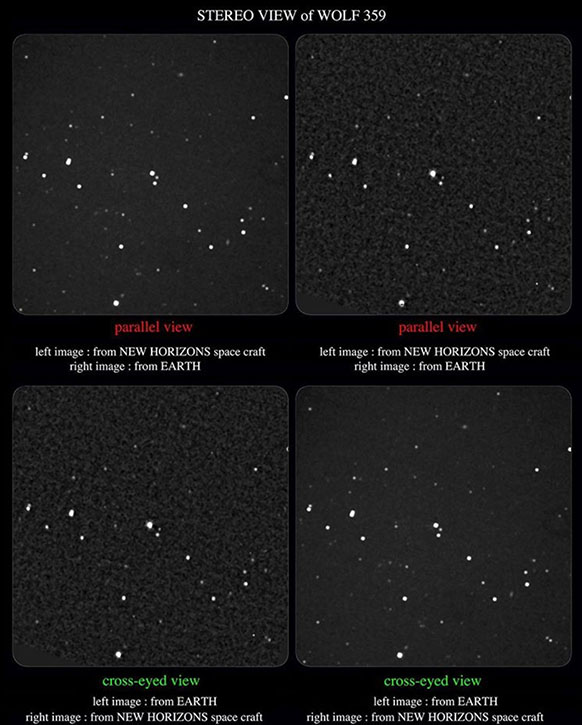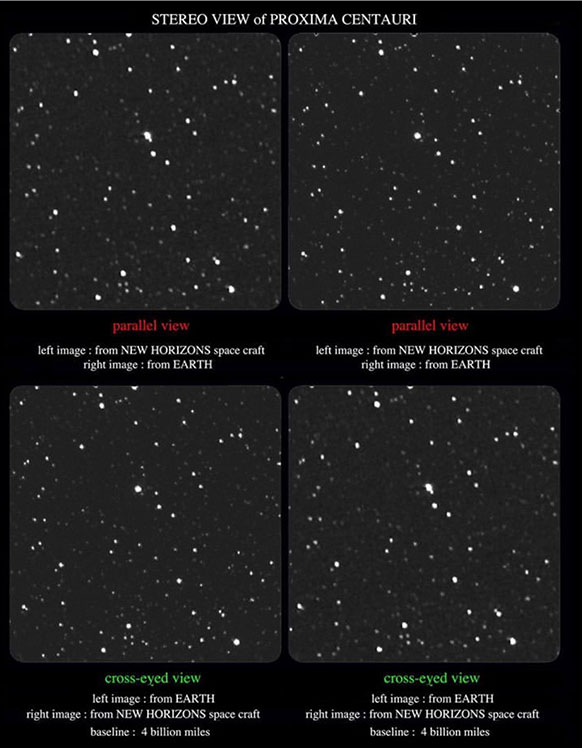



New Horizons triumphs again !! This is a media report of what was revealed today by the NASA ‘New Horizons’ team – the amazing outfit which sent the fastest spacecraft in history out to the far reaches of the Universe, on a 12 year journey to photograph the Planet Pluto at close quarters. The craft then sped on to rendezvous with a remote Kuiper Belt Object (KBO) now named Arrokoth. Again it secured the first photographs in history of such a far-flung rock. But now New Horizons has pulled off another first – the longest baseline stereoscopic picture in history, and the first simultaneous parallax measurement of a nearby star – Proxima Centauri. And, just to show it wasn’t a one-off – also a second parallax study – of another neighbouring star – Wolf 359.
Wanna see the results ? Next [below], if my brain will hold out !!!
I’m well proud to be a member of this team. This WASN’T my idea – that honour goes to Tod Lauer – but I was able to throw in a few small contributions. Next post will show the results !!!
—
The New Horizons Parallax experiment ! This great GIF movie by John Spencer of the NH team sums it all up. What are we looking at? We are flicking between two views of the same part of the starry sky. One view was taken from Earth, and the other was captured by the New Horizons spacecraft, over 4,000,000,000 miles away. That’s 4 BILLION miles ! The star that moves back and forth is Proxima Centauri – the closest star to our own Sun. Viewed from the Earth, this star appears in the left-hand position, and viewed from the spacecraft, it appears displaced to the right. This is actually NOT rocket science (although it was made possible by Rocket Science, of course !!!) It’s just the same as if you took two pictures of your best friend standing in front of a distant forest background. If you moved your camera sideways between exposures, you would see him in two different positions Relative to the background in the two photographs you took. And if you made a movie flashing between the two pictures, you would see your best friend moving sideways back and forth, just like Proxima Centauri is doing here.
Brian May: “The New Horizons Parallax experiment ! GIF movie by John Spencer 13 June 2020 (01)
– https://youtu.be/uXNJtUF4Uow
[Next]…you can see another close start doing the same thing, the second part of this experiment. This change of relative positions due to change of viewpoint is called PARALLAX. Personally, I find this movie mesmerising. But of course we all know that this is a great opportunity to make a stereoscopic 3-D image, and it’s exciting, because this stereoscopic image will have the largest baseline ever achieved in a 3-D photograph.
Brian May: “The New Horizons Parallax experiment ! GIF movie by John Spencer 13 June 2020
– https://youtu.be/OK1LqMeJdCU
I’ll show you the 3-D pictures in next. But you can check out the official NASA story by clicking the link NASA RELEASE
—
These are the stereos we were able to construct. These are the first ever simultaneous stereos of nearby stars, and the baseline is the longest ever employed in a stereo (3-D) photograph. Proud to be part of the New Horizons team. #nhparallax CREDIT: NASA / Johns Hopkins University Applied Physics Laboratory.


SEE ALSO IN BRIAN NEWS
Bri
@ brianmay.com